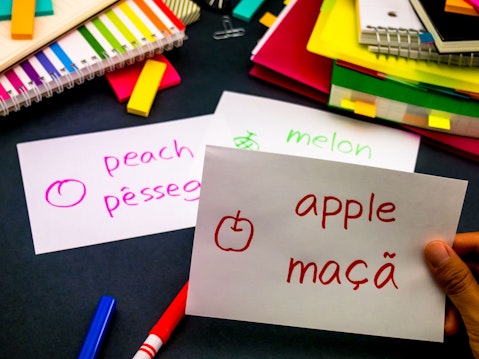In this article, we will be taking a look at the 16 easiest second languages to learn for English speakers. If you don’t want to get into the details of learning a second language, feel free to skip and head straight to the 5 Easiest Second Languages To Learn For English Speakers.
Learning a second language opens up opportunities, allowing individuals to connect with different cultures, enhance their cognitive abilities, and broaden their career prospects. For English speakers seeking a relatively smooth transition into multilingualism, specific languages present themselves as more accessible than others. This article explores some of the easiest second languages for English speakers to learn, whether it’s due to shared linguistic roots, more superficial grammar structures, or the widespread availability of resources.
Importance of Learning a Second Language in Business
Learning a new language can be challenging, especially for native English speakers. However, certain factors can make language learning easier. One of the most important factors is the similarity between the new language and English. Languages like Spanish and French, which share many similarities with English in terms of vocabulary and grammar, are the easiest second languages to learn if you speak English.
Another critical factor is immersion. Immersing in the language and culture can accelerate the learning process, which can be achieved through traveling to a country where the language is spoken, taking classes with native speakers, or even watching movies or TV shows in the new language. Finally, motivation and dedication are crucial factors in language learning.
Having a strong desire to learn the language and dedicating time and effort to studying and practicing can significantly increase the chances of success. Studies show that motivated and dedicated students are more likely to succeed in language learning. For example, a recent survey found that students who spent at least 10 hours a week studying a new language were more likely to achieve fluency within a year. In this regard, Spanish, one of the 25 most spoken languages in the world, is the easiest language for a child to learn.
The global language learning market is expected to reach $191.6 billion by 2028, with a compound annual growth rate of 18.8%. This growth is driven by globalization, international business, and the increasing popularity of language learning apps and online courses.
Resources and Tools for Learning Easier Second Languages
Learning a second language can be a valuable asset in the business world. It can open up new opportunities for communication and collaboration with international partners and clients. Studies have shown that employees who speak a second language can earn up to 20% more than their monolingual counterparts. However, learning a new language can be challenging and time-consuming.
Fortunately, many resources and tools are available to make the process easier. One of the popular resources for learning a second language is language learning apps. These apps allow users to practice listening, speaking, reading, and writing skills through interactive lessons and activities. Duolingo, Inc (NASDAQ:DUOL), one of the most popular language-learning apps, has over 300 million users worldwide. Duolingo, Inc (NASDAQ:DUOL) also provides language certification.
Popular platforms like Coursera, Inc. (NYSE:COUR) and Rosetta Stone have grown significantly in recent years. Coursera, inc. (NYSE:COUR) offers both free and paid courses, including on languages, with the option to earn certificates or even pursue professional certificates and degree programs. Coursera, Inc. (NYSE:COUR) and Duolingo, Inc. (NASDAQ:DUOL)’s language courses cater to different proficiency levels, from beginner to advanced, making them suitable for learners at various stages of their language learning journey.
Another valuable tool for learning a second language is language exchange programs. These programs allow users to connect with native speakers of the language they are learning for conversation practice. Italki, one of the most popular language exchange programs, has over 3 million registered users from more than 100 countries.
Tandem and HelloTalk are also popular language exchange programs with millions of users. In addition to apps and language exchange programs, many online resources are available for language learners. Websites like FluentU and Lingoda offer online courses and resources for learning various languages. In fact, Lingoda has over 10,000 students enrolled in its online language courses.

Copyright: eikotsuttiy / 123RF Stock Photo
Our Methodology
Our methodology for identifying the easiest second languages for English speakers involved conducting thorough research using sources like Dorothy Memory, Berlitz, Promova, and Gooverseas. We selected the easiest second languages to learn for English speakers based on a structured scoring system. Each language received points based on the number of times it appeared in the research sources. By employing this approach, we created a definitive compilation of the top easiest second languages to learn for English speakers and ranked them in ascending order of high score.
Here is our list of the easiest second languages to learn for English Speakers.
16. Haitian Creole
Insider Monkey Score: 1
Haitian Creole, spoken by around 10 million people in Haiti, is one of the most widely spoken languages globally. It falls under the FSI Category 2, meaning English speakers can learn it in about 36 weeks. This fascinating language combines French and African influences with additional English, Portuguese, and Spanish traces. English speakers have an advantage due to the increasing number of shared words and cognates. Haitian Creole’s simplified grammar, with minimal conjugations and inflections, further facilitates learning.
15. Welsh
Insider Monkey Score: 1
Despite not all residents of Wales being fluent in Welsh, the language is considered accessible to learn. Only 29.1 percent of individuals aged three or above can speak Welsh. It features a more straightforward spelling system than English, with some familiar sounds for English speakers, although specific phonemes like “ll” and “rh” may require practice.
Welsh vocabulary displays noticeable similarities among related words, facilitating the expansion of one’s lexicon. Examples include “llyfr” (book), “llyfrgell” (library), and “llyfryddiaeth” (bibliography). Welsh borrows from Latin, similar to English, and employs logical prefixes in compound word formation, requiring some adjustment but maintaining coherence.
14. Malay
Insider Monkey Score: 2
Malay, the native language of Malaysia, is an appealing choice for English speakers as it lacks verb conjugations, plurals, tenses, and genders. With around 57 million speakers worldwide and a significant presence in Indonesia, Malay can be learned within about 36 weeks. It is not tonal, uses syllables for pronunciation, and utilizes the Latin script, similar to English.
Malay and Indonesian, both Austronesian languages, share similarities but differ in spelling, pronunciation, and vocabulary. Considered one of the easiest Asian languages to learn, Malay’s simple grammar and pronunciation make it valuable for Southeast Asia travelers.
13. Swahili
Insider Monkey Score: 2
Swahili, spoken in eastern and southeastern Africa, is considered one of the easiest languages for English speakers to learn. With approximately 15 million native speakers, Swahili lacks tone and has straightforward pronunciation. It incorporates borrowed words from English, making it appealing to language learners.
Swahili follows logical grammar patterns using prefixes instead of conjugations. It is widely spoken in East Africa and is a valuable second language. Recognizable words like “Rafiki” and “Simba” from “The Lion King” highlight its familiarity, and its pronunciation and similarities to English facilitate learning. Swahili is an excellent entry point for those interested in African languages.
12. Indonesian
Insider Monkey Score: 2
Indonesian, categorized as a precise language for English speakers by FSI, offers a direct learning experience. With approximately 900 hours of study, learners can join the 43 million native speakers of Indonesian. The language’s advantages include:
- The continued use of the phonetic Latin alphabet.
- The absence of gendered nouns.
- Similarity to English vocabulary.
Indonesian utilizes prefixes and suffixes for word modification instead of tones or distinct verb endings. Despite being an Austronesian language, Indonesian’s phonetic spelling and familiar sentence structure make it accessible to English speakers. Pluralization involves repeating the word or adding an extra one, adding to the language’s simplicity.
11. Esperanto
Insider Monkey Score: 2
Esperanto, created by L.L. Zamenhof as a universal language, is spoken by over two million people. It features phonetic spelling, simple word order, predictable patterns, and only 16 grammar rules. With streamlined communication and considered the most accessible language, Esperanto is a gateway to other languages. Despite not being adopted as an official language, it enjoys support from the European Union and PEN International. Esperanto’s regularity, derived vocabulary, and absence of irregularities in verb tenses, plurals, and prepositions contribute to its appeal
10. Frisian
Insider Monkey Score: 2
Frisian, considered the easiest language for English speakers to learn, shares the closest resemblance to English. It is the second official language in the Netherlands, spoken by about 450,000 people in Friesland. Frisian and English belong to the Angofrisian group within Germanic languages, sharing structural and lexical similarities.
With subsets like Frysk-West Frisian, Nordfrasch, and Seeltersk-Saterland Frisian, Frisian demonstrates significant lexical similarity with English, including words like “welcome.” Although Frisia no longer exists, with its three main dialects, Frisian is still spoken in parts of the Netherlands and Germany.
Frisian and English have similarities in sentence structure and vocabulary. Learning Frisian may be practical for those planning to live in specific regions such as Friesland or the Saterland and North Frisia regions in the Netherlands and Germany.
9. Danish
Insider Monkey Score: 2
Danish, with its similar grammar patterns and shared Germanic origins, can be learned by English speakers in just 24 weeks, according to FSI. The language offers numerous cognates, facilitating vocabulary acquisition. Danish becomes an attractive choice with the 80/20 rule and only nine verb forms.
Spoken by around 5.5 million people, primarily in Denmark, Danish shares straightforward grammar rules with Norwegian and Swedish, and familiar words exist for English speakers. Despite the challenging pronunciation, learning Danish is essential for immersing oneself in Danish culture and forming deeper connections, particularly during an extended stay in Denmark.
8. Afrikaans
Insider Monkey Score: 2
Afrikaans, the official language of South Africa, is considered the easiest language for native English speakers to learn. It shares West Germanic origins with English, leading to many Germanic-derived root words. Afrikaans does not require changes in vocabulary for gender, number, or tense, simplifying sentence construction. It has only three tenses and does not use verb conjugation or pronouns.
Like Dutch and other West-Germanic languages, Afrikaans offers familiar sentence structures and a lack of gendered nouns.
7. Swedish
Insider Monkey Score: 3
Knowing the Swedish language besides English can be very fruitful. Around 10 million people speak it. Learning Swedish is easy because of its linguistic proximity to other Germanic languages. There’s a lot of vocabulary and grammar in Swedish that it shares with the English language.
6. Romanian
Insider Monkey Score: 3
Learning Romanian is an intelligent move for English speakers. Knowing Romanian provides a competitive edge in the job market, as many multinational corporations operate in Eastern Europe and seek bilingual professionals. It is one of the easiest languages to learn for English speakers.
Click to see and continue reading the 5 Easiest Second Languages To Learn For English Speakers.
Suggested Articles:
- 11 Easiest Instruments to Learn for a Child.
- 15 Best Beach Towns for Retirement
- 25 Most Spoken Languages In The World.
Disclosure. None: The 16 Easiest Second Languages To Learn For English Speakers is originally published on Insider Monkey.





